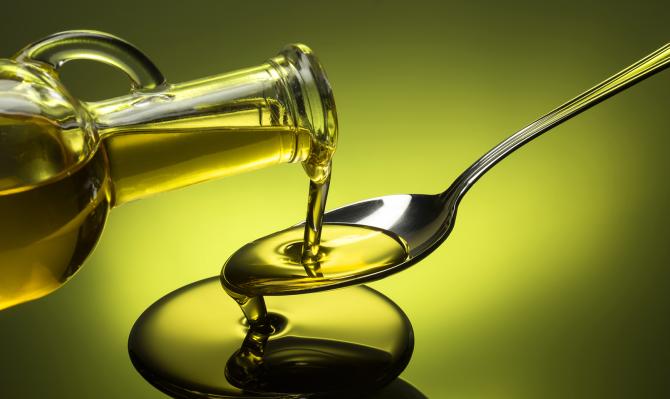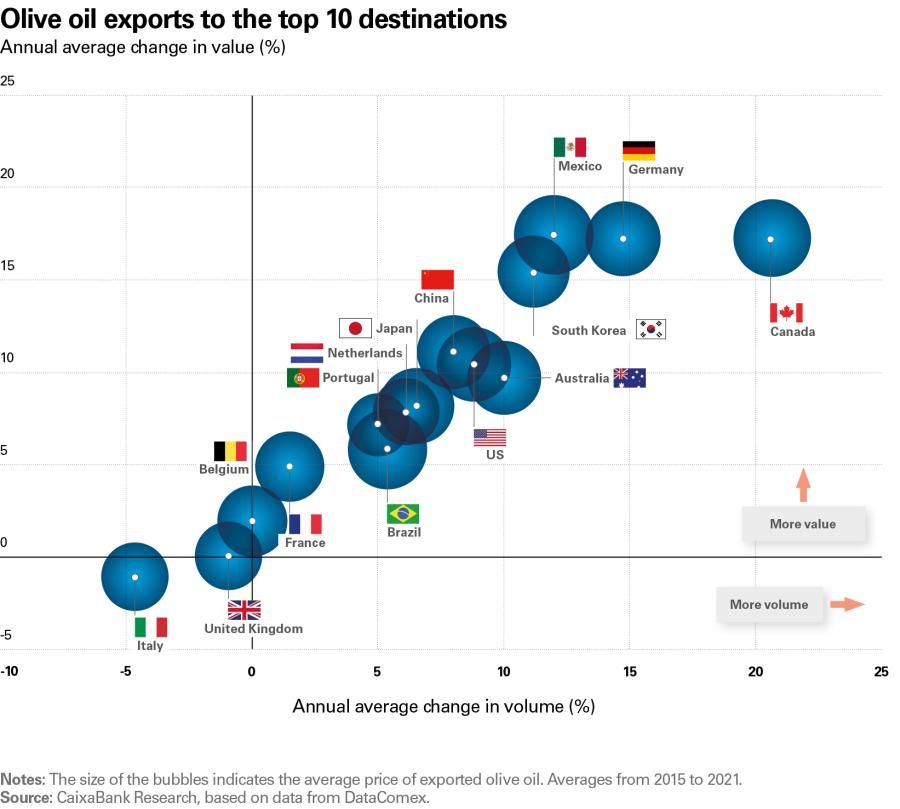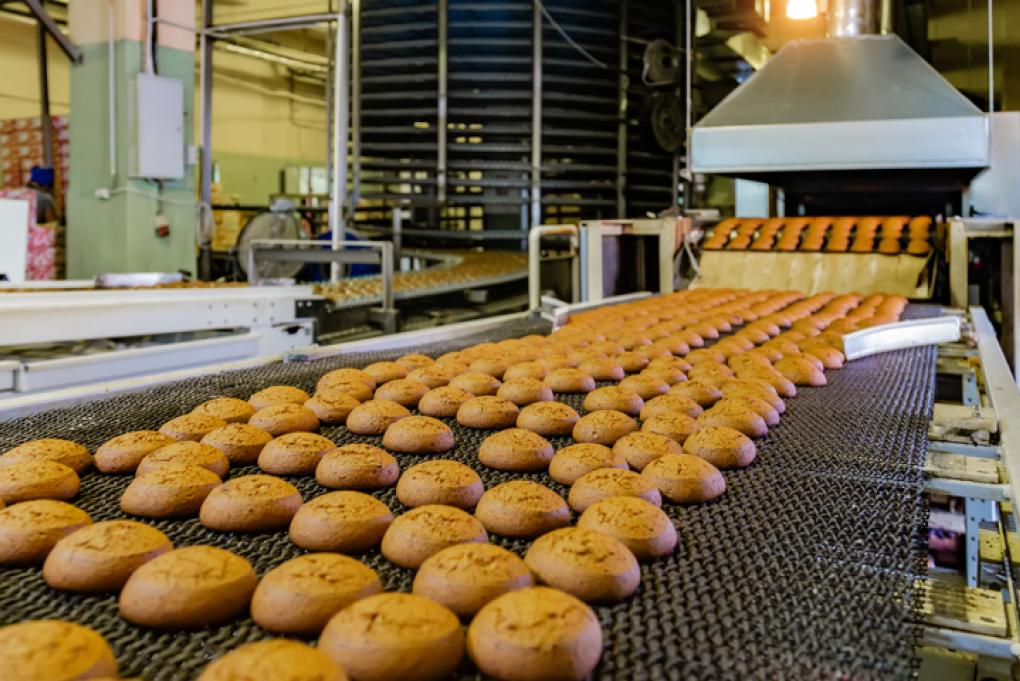
Spanish olive oil: the liquid gold that must be developed further
The olive oil industry is a deeply-rooted, traditional sector in Spain, is one of the most important in the country’s agricultural sector and plays a fundamental role from an economic, environmental, cultural and gastronomic point of view. In addition to being a source of income and employment in many rural areas, it also contributes towards territorial and social cohesion and the fight against depopulation, soil erosion and climate change.
The role played by the olive oil industry in Spain
With nearly 340 million olive trees, Spain is the world leader in terms of surface area, production, marketing and export of olive products, both olives and, especially, olive oil. Consequently, more than 90% of the cultivated land and olive production is aimed at the production of oil. 23% of the total production of olive oil is organic, a product that is increasingly in demand and falls within the framework of sustainable agriculture practices.
The olive oil industry is typically fragmented, a handicap that hinders its competitiveness and the bargaining power of producers.
The olive oil industry is a highly fragmented sector, with a large number of participants throughout the different stages of the value chain.23 First, there are more than 380,000 farms with a very small average size (7 hectares): 52% have less than 5 hectares and only 16.5% have more than 20 hectares; 24 almost 87% of the farms, with 76% of the area, are non-irrigated.
More than 3,5000 different players are involved in the industrial process of producing olive oil, including mills, bottling plants, olive residue mills/extraction plants and refineries.25 There is also a wide variety of industries linked to the sector: on the one hand, those that provide fertilisers and phytosanitary products, machinery, equipment, facilities, etc.; on the other hand, those that use olive oils as input, whether in the food sector itself or in the pharmaceutical and cosmetics sector.
The cooperative model of business is widespread,26 especially in the early stages of oil processing: cooperatives account for about 50% of the mills, which produce almost 70% of the olive oil in Spain, and about 40% of the bottling plants, which tend to be small and play only a limited role in the market, in contrast to the large trading companies.
As for distribution, in terms of the companies responsible for selling oil, supermarkets and other self-service stores account for almost half the sales, followed, at a great distance, by hypermarkets and discount stores.
- 23MAPA (2021): Estudio de la cadena de valor del aceite de oliva virgen extra en España. Campañas 2018-2019 y 2019-2020.
- 24National Statistics Office (2020): Encuesta sobre la estructura de las explotaciones agrícolas, 2016; and MAPA (2020): Ficha Sectorial por Orientación Técnico Económica (OTE), Olivar (data from 2017).
- 25MAPA (2021): Informe mensual de la situación de mercado del sector del aceite de oliva. Campaña 2020-2021.
- 2635% of the cooperatives in Spain’s agrifood sector are involved in producing olive oil, this being the second most important production within the cooperative sector in terms of direct turnover, with 15% of the total in 2019. OSCAE (2020): El cooperativismo agroalimentario español. Informe socioeconómico 2019. Cooperativas Agroalimentarias de España.
Oil consumption got back to normal in 2021 after an extraordinary previous year
As a consequence of the restrictions imposed to contain the pandemic, in 2020 households increased their consumption of olive oil (the most commonly consumed oil in Spanish families)27 by an extraordinary 15.6% to nearly 214 million litres, the highest figure in four years. The increase in value was much lower, up 3.2% to almost €541 million, due to the sharp decline in the average price, down 10.8% to €2.53/litre, the lowest since 2012. By distribution channel, within a context of almost generalised growth but with the exception of traditional shops, e-commerce stands out in particular, posting extraordinary growth of 67.6%, reaching 4.2% of the total.
- 27MAPA (2021): Informe anual de consumo alimentario 2020. MAPA no longer publishes consumption figures for the HORECA channel and only refers to oil used as dressing outside the home, which in 2020 plummeted by 41.8%.
Olive oil is the most commonly consumed by households, with 35% of the total volume, and its demand is characterised by a high price sensitivity.
Throughout 2021, as a result of the shorter time spent at home, the reopening of the HORECA channel and decrease in pantry purchases, a change in trend was observed in oil consumption, posting a 12.7% year-on-year decline (accumulated data for 12 months up to November). However, the sharp rise in the average price (+10.1%) cushioned this decline in value terms (–3.9%).
The olive oil industry is a deeply-rooted, traditional sector in Spain, is one of the most important in the country’s agricultural sector and plays a fundamental role from an economic, environmental, cultural and gastronomic point of view. In addition to being a source of income and employment in many rural areas, it also contributes towards territorial and social cohesion and the fight against depopulation, soil erosion and climate change. The industry is made up of small companies, which hinders economies of scale and the capacity for innovation. Its main asset is the great potential offered by global markets for a product that is increasingly in demand thanks to its quality and properties. To take advantage of this competitive advantage, the industry must improve its focus on the end customer, enhance differentiation that adds value and defend its leadership and brand positioning in international markets.
The normalisation of oil sales in 2021 could be seen across almost all the channels except for traditional shops, where sales grew by 10.2%, exceeding their pre-pandemic level. In the case of online purchases, and despite the decline in 2021, sales are now well above their 2019 level and continue to enjoy a market share of close to 4.0%. On the other hand, sales via the main channels (hypermarkets, supermarkets, self-service and discount stores) are somewhat below their pre-crisis levels.
Absolute leader in the international olive oil trade
Spain’s olive oil industry is strongly export-oriented: almost 80% of the oil produced is destined for foreign markets (more than one million tonnes in the 2020-2021 season), ranking third among the country’s agrifood exports behind pork and citrus fruits. Olive oil is sold to more than 160 countries, although 81% of the volume is concentrated in the top 10, with Italy as the main buyer (28.2% of the total). Our EU partners receive 57% of the total although their share has decreased significantly (16 points since 2010), a sign of the diversification of destinations in recent years. As can be seen in the following chart, Spain has a large degree of geographical diversification in its exports, which is greater than that of our main rivals and has increased in recent years.
Spain has a powerful and geographically diversified olive oil export industry, albeit with a problem of low prices.
Spain is the world’s leading exporter of olive oil, both in terms of volume and value but while, in the first case, it practically triples the exports of Italy, the second country in the ranking, the gap in terms of value is considerably smaller. The explanation lies in the average prices, which are much higher in the Italian case: €4.42 per kg for the 2015-2021 average, compared to €3.22 per kg for Spanish oil.
This lower average export price compared to our competitors is closely related to the large share of bulk exports, around two thirds of the total,28 which are mainly destined for EU countries,29 especially Italy which packages and resells the oil under its own brands. This is one of the industry’s main problems: the loss of added value and brand positioning because it lacks an adequate marketing strategy, something that its competitors know how to take advantage of (with Italy being a case in point).
However, in recent years the industry has improved its positioning in international markets. As can be seen in the following chart, some of the countries that pay a higher price (Germany, Australia, US and Mexico) have increased their relative weight in total exports, both in terms of value and volume. Other countries (below the top 10 but also paying above-average prices) where the penetration of Spanish oil is increasing are South Korea, Canada and Russia. In the case of Portugal (the second destination by volume within the EU and the third worldwide), exports reached record levels although the average price is the lowest of the main destinations. On the other hand, France, the United Kingdom30 and, above all, Italy, all paying lower prices, are losing ground.
- 282019-2020 campaign. Caja Rural de Jaén (2021): Informe Anual de Coyuntura del Sector Oleícola.
- 29According to data from the last campaign (MAPA), the average price of oil sold to our EU partners is 16% lower than that sold outside the EU.
- 30In this case, the slump in exports last year (–39.0%) may have been partly caused by sales brought forward in 2020 due to fears of a no-deal Brexit.

Foreign sales of olive oil were affected by the pandemic but have recovered remarkably well in value terms thanks to the price increase in 2021. Specifically, exports recorded a 5.1% drop in value in 2020, resulting in a series of three consecutive years of declines (–23.5% cumulative). However, in terms of volume, sales slowed significantly in 2020 but still posted growth of 4.4%. Foreign sales were affected not only by the adjustment in demand in the midst of the pandemic but also by the tariffs imposed in October 2019 by the US,31 the second largest export destination. In this respect, the agreement reached with the EU in June 2021 to suspend tariffs for at least five years was excellent news for the industry.32 In fact, 2021 saw olive oil exports to the US pick up sharply (10.0%). Taking all destinations into account, in 2021 exports rebounded by 16.5% in value terms (up 10.6% compared to 2019). This occurred in a context of lower production in the main competing countries,33 so that prices recovered after three years of a downward trend (in volume terms, olive oil exports fell by 5.3% in 2021).
- 31These tariffs, set at 25%, affected 113 categories of Spanish products, accounting for 53.1% of all products exported to the US. According to the Spanish Association of the Olive Oil Export Industry and Trade (Asoliva), in the year and a half these tariffs were in force, Spain stopped exporting 80,000 tonnes of oil and lost around 1.2 billion euros.
- 32The average tariffs of 35% applied to black table olives were maintained, although a resolution of this conflict seems to be imminent, following acceptance by the US of a WTO report that concluded these tariffs are contrary to WTO rules.
- 33The combined production of Italy, Greece, Tunisia, Turkey, Morocco and Portugal in the 2020-2021 season decreased by 27%. Alimarket (2022): Informe 2022 del sector de Aceite de Oliva en España.
Cost problems are getting worse
The olive oil industry is facing some intrinsic problems that are putting a strain on its costs and hindering its profitability and competitive capacity. First, beyond the logical impact of weather conditions (for example, the drought between late 2021 and early 2022 has pushed down the production forecast for the 2021-2022 season), the variability of olive harvests34 influences (i) operating costs, especially in traditional non-mechanisable farms, which account for 22% of the total and have lower yields and higher costs,35 and (ii) extraction costs, especially in cooperative mills, due to less flexibility to adjust their activity and workforces. This, in turn, leads to high volatility in product prices.
- 34There is the phenomenon of alternate harvests, the causes of which are not well known. This means that an abundant harvest tends to be followed by a year in which yields are smaller.
- 35The high cost of traditional non-mechanisable farms makes them unprofitable, even with CAP subsidies. However, public authorities and business organisations are working to defend traditional olive groves as they help to combat climate change, soil erosion and to maintain biodiversity.
In addition to the aforementioned problems, in recent months there has been an increase logistic and production costs (diesel, fertilisers, packaging, water, etc.) and bottlenecks in global supply chains, affecting not only the olive industry but the entire agricultural sector. The conflict in Ukraine represents another shock for the energy sector, with global value chains taking even longer to get back to normal. The risk is that these tensions may damage the profitability of farms and producers and end up being passed on to final prices, in a sector with very narrow margins, with the consequent impact on its competitiveness and consumption. The rising cost of sea freight due to the shortage of containers is another distorting factor that could slow down the performance of exports to emerging destinations such as Asia or the United States.
To cushion these fluctuations, last year the government approved a new regulation36 that will allow product to be withdrawn in those seasons with excess production. The industry is also looking to harvest earlier to regulate supply and cushion the impact of the dry season, as the olive trees recover better. In addition, earlier olive harvesting generates higher quality olive oil, which in turn generates higher prices.
Another handicap for the industry’s profitability is the dual nature of the cultivation system, with low-yield traditional farms versus intensive and super-intensive farms. Almost half the olive groves in Spain are traditional and mechanisable, whereas only 3% are super-intensive: in the first case, the yield per hectare is between 40% and 65% lower while the cost of production can be twice as high.37 Although still in a minority, in recent years there has been a notable increase in the number of hectares of super-intensive (and intensive) olive farming, a system that facilitates mechanisation. In short, crop intensification and mechanisation go hand in hand and make it possible to increase production, reduce costs and obtain higher quality oils.
- 36Royal Decree 84/2021 of 9 February, establishing the basic rules for the application of Article 167a of Regulation (EU) No. 1308/2013 of the European Parliament and of the Council of 17 December 2013 establishing a common organisation of the markets in agricultural products.
- 37MAPA (2021): Estudio de la cadena de valor del aceite de oliva virgen extra en España. Campañas 2018-2019 y 2019-2020; and MAPA (2020): Encuesta sobre superficies y rendimientos de cultivos (ESYRCE). Análisis de las plantaciones de olivar en España, 2019.
In addition to the usual problems facing the olive industry, such as droughts and harvest variability, costs are also increasing.

One of the hallmarks of our olive oil is quality and Spain has decided to lead the world in terms of quality requirements. In 2021, a standard38 was approved that includes a series of requirements regarding traceability, processing and packaging, which will enhance the reputation of Spanish olive oil in the world and offer maximum transparency and guarantees to the consumer. As part of this standard, MAPA has had a computerised system in operation since October 2021 in which bulk oil movements and internal movements between mills, refineries and extraction plants must be recorded.
In recent years, especially with the outbreak of the pandemic, concern for health and environmental care has grown. In turn, this has boosted the consumption of foods considered to be healthy, olive oil being one of them, as well as a commitment to organic products and biodiversity. Spain is the world’s leading producer of organic olive oil, a strength that should be highlighted.
- 38Royal Decree 760/2021, of 31 August, approving the quality standard for olive and olive residue oils.
A commitment to quality and added value
It has been shown that Spain’s olive oil industry has an enormous production capacity but it must go a step further and become more market-oriented. To this end, the attributes of our olive oil must be promoted, which are a source of differentiation, give added value to the product and, very importantly, fulfil consumer demands.
Spain must look for differentiating features that add value to its olive oil.




